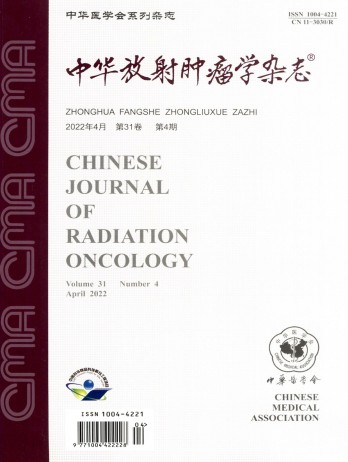Comparison of survival between neoadjuvant chemoradiotherapy and neoadjuvant chemotherapy followed by surgery for esophageal squamous cell carcinoma
引用次数: 0
Abstract
Objective To compare the effect of neoadjuvant chemoradiotherapy (NCRT) and neoadjuvant chemotherapy (NCT) on the survival of patients with esophageal cancer. Methods Clinical data of 275 cases of thoracic esophageal squamous cell carcinoma treated with neoadjuvant therapy combined with surgery from December 2011 to December 2015 were analyzed retrospectively. The data of treatment and follow-up were complete and analyzable. There were 70 cases in the NCRT group and 205 cases in the NCT group. The survival rate was calculated by Kaplan-Meier method and statistically compared by log-rank test, and multivariate analysis was performed by Cox regression model. Results The median follow-up time was 32(3-84) months. The median survival time and recurrence-free survival time was 42(3-84) months and 30(3-84) months, respectively. The overall 3-and 5-year survival rates were 56.8% and 45.9%, respectively, and the 3-and 5-year recurrence-free survival rates were 45.1% and 38.9%, respectively. The median survival time in the NCRT and NCT groups was 46(7-84) and 40(4-74) months, and the median recurrence-free survival time was 31(3-84) and 28(3-69) months, respectively. The 3-and 5-year overall survival of the two groups were 59.1%, 47.1% and 56.3%, 47.5%(P=0.515), and the 3-and 5-year recurrence-free survival were 44.5%, 40.1% and 47%, 39%, respectively. There was no significant difference in the survival between two neoadjuvant therapy modes (P=0.554). Multivariate analysis showed that postoperative pathological TNM staging was an independent factor affecting the prognosis of patients with esophageal cancer (P=0.001). Conclusions The survival results of NCRT are similar to those of NCT. Postoperative pathological staging is an independent survival factor. Key words: Esophageal neoplasm/neoadjuvant radiotherapy; Esophageal neoplasm/neoadjuvant chemotherapy; Prognosis食管鳞状细胞癌新辅助放化疗与手术后新辅助化疗的生存率比较
目的比较新辅助放化疗(NCRT)和新辅助化疗(NCT)对食管癌症患者生存率的影响。方法回顾性分析2011年12月至2015年12月采用新辅助治疗结合手术治疗的275例胸段食管鳞状细胞癌的临床资料。治疗和随访的数据是完整的和可分析的。NCRT组70例,NCT组205例。生存率采用Kaplan-Meier法计算,对数秩检验进行统计学比较,Cox回归模型进行多变量分析。结果中位随访时间为32(3-84)个月。中位生存时间和无复发生存时间分别为42(3-84)个月和30(3-84)个月。总的3年和5年生存率分别为56.8%和45.9%,3年和五年无复发生存率分别是45.1%和38.9%。NCRT组和NCT组的中位生存时间分别为46(7-84)和40(4-74)个月,无复发生存时间的中位分别为31(3-84)和28(3-69)个月。两组的3年和5年总生存率分别为59.1%、47.1%和56.3%、47.5%(P=0.515),3年和五年无复发生存率分别是44.5%、40.1%和47%、39%。两种新辅助治疗方式的生存率无显著差异(P=0.554)。多因素分析表明,术后病理性TNM分期是影响癌症患者预后的独立因素(P=0.001)。术后病理分期是一个独立的生存因素。关键词:食管肿瘤/新辅助放疗;食管肿瘤/新辅助化疗;预后
本文章由计算机程序翻译,如有差异,请以英文原文为准。
求助全文
约1分钟内获得全文
求助全文
来源期刊
自引率
0.00%
发文量
6375
期刊介绍:
The Chinese Journal of Radiation Oncology is a national academic journal sponsored by the Chinese Medical Association. It was founded in 1992 and the title was written by Chen Minzhang, the former Minister of Health. Its predecessor was the Chinese Journal of Radiation Oncology, which was founded in 1987. The journal is an authoritative journal in the field of radiation oncology in my country. It focuses on clinical tumor radiotherapy, tumor radiation physics, tumor radiation biology, and thermal therapy. Its main readers are middle and senior clinical doctors and scientific researchers. It is now a monthly journal with a large 16-page format and 80 pages of text. For many years, it has adhered to the principle of combining theory with practice and combining improvement with popularization. It now has columns such as monographs, head and neck tumors (monographs), chest tumors (monographs), abdominal tumors (monographs), physics, technology, biology (monographs), reviews, and investigations and research.

 求助内容:
求助内容: 应助结果提醒方式:
应助结果提醒方式:


